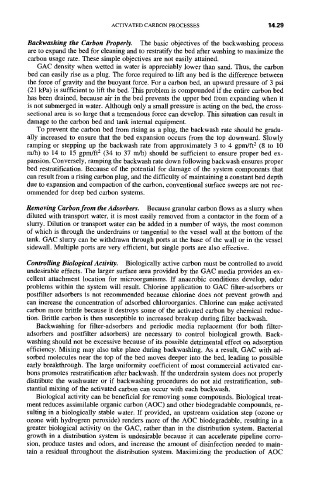Page 481 -
P. 481
ACTIVATED CARBON PROCESSES 14.29
Backwashing the Carbon Properly. The basic objectives of the backwashing process
are to expand the bed for cleaning and to restratify the bed after washing to maximize the
carbon usage rate. These simple objectives are not easily attained.
GAC density when wetted in water is appreciably lower than sand. Thus, the carbon
bed can easily rise as a plug. The force required to lift any bed is the difference between
the force of gravity and the buoyant force. For a carbon bed, an upward pressure of 3 psi
(21 kPa) is sufficient to lift the bed. This problem is compounded if the entire carbon bed
has been drained, because air in the bed prevents the upper bed from expanding when it
is not submerged in water. Although only a small pressure is acting on the bed, the cross-
sectional area is so large that a tremendous force can develop. This situation can result in
damage to the carbon bed and tank internal equipment.
To prevent the carbon bed from rising as a plug, the backwash rate should be gradu-
ally increased to ensure that the bed expansion occurs from the top downward. Slowly
ramping or stepping up the backwash rate from approximately 3 to 4 gpm/ft 2 (8 to 10
m/h) to 14 to 15 gpm/ft 2 (34 to 37 m/h) should be sufficient to ensure proper bed ex-
pansion. Conversely, ramping the backwash rate down following backwash ensures proper
bed restratification. Because of the potential for damage of the system components that
can result from a rising carbon plug, and the difficulty of maintaining a constant bed depth
due to expansion and compaction of the carbon, conventional surface sweeps are not rec-
ommended for deep bed carbon systems.
Removing Carbon from the Adsorbers. Because granular carbon flows as a slurry when
diluted with transport water, it is most easily removed from a contactor in the form of a
slurry. Dilution or transport water can be added in a number of ways, the most common
of which is through the underdrains or tangential to the vessel wall at the bottom of the
tank. GAC slurry can be withdrawn through ports at the base of the wall or in the vessel
sidewall. Multiple ports are very efficient, but single ports are also effective.
Controlling Biological Activity. Biologically active carbon must be controlled to avoid
undesirable effects. The larger surface area provided by the GAC media provides an ex-
cellent attachment location for microorganisms. If anaerobic conditions develop, odor
problems within the system will result. Chlorine application to GAC filter-adsorbers or
postfilter adsorbers is not recommended because chlorine does not prevent growth and
can increase the concentration of adsorbed chloroorganics. Chlorine can make activated
carbon more brittle because it destroys some of the activated carbon by chemical reduc-
tion. Brittle carbon is then susceptible to increased breakup during filter backwash.
Backwashing for filter-adsorbers and periodic media replacement (for both filter-
adsorbers and postfilter adsorbers) are necessary to control biological growth. Back-
washing should not be excessive because of its possible detrimental effect on adsorption
efficiency. Mixing may also take place during backwashing. As a result, GAC with ad-
sorbed molecules near the top of the bed moves deeper into the bed, leading to possible
early breakthrough. The large uniformity coefficient of most commercial activated car-
bons promotes restratification after backwash. If the underdrain system does not properly
distribute the washwater or if backwashing procedures do not aid restratification, sub-
stantial mixing of the activated carbon can occur with each backwash.
Biological activity can be beneficial for removing some compounds. Biological treat-
ment reduces assimilable organic carbon (AOC) and other biodegradable compounds, re-
suiting in a biologically stable water. If provided, an upstream oxidation step (ozone or
ozone with hydrogren peroxide) renders more of the AOC biodegradable, resulting in a
greater biological activity on the GAC, rather than in the distribution system. Bacterial
growth in a distribution system is undesirable because it can accelerate pipeline corro-
sion, produce tastes and odors, and increase the amount of disinfection needed to main-
tain a residual throughout the distribution system. Maximizing the production of AOC

